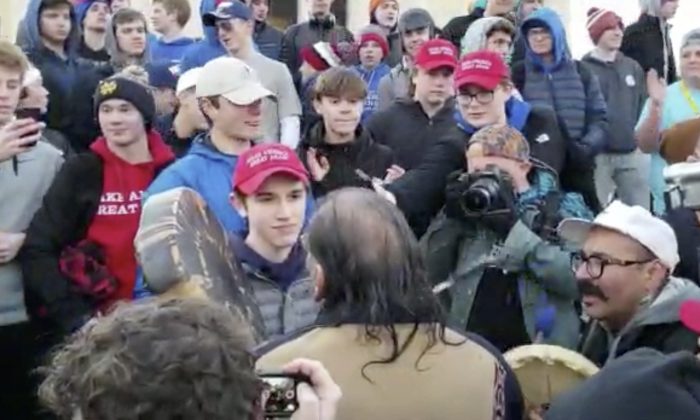Investigators have concluded that the group of high school students involved in a confrontation in Washington that went viral did not instigate the confrontation.
Three groups converged on Jan. 22 in front of the Lincoln Memorial—Covington Catholic High School students, fresh from the March for Life and awaiting buses to take them back to Kentucky; Native Americans, who were part of an Indigenous People March; and Black Hebrew Israelites, a fringe religious group that shouted slurs at the two other groups.
A short video clip from the confrontation showing activist Nathan Phillips, a Native American, banging a drum in the face of Covington student Nick Sandmann as the teenager stood still and smiled went viral. Phillips claimed the students shouted things at him and his group, including “Build the Wall,” but no video evidence of that has emerged. He also said the students blocked him from going to the memorial.
But full video footage of the interaction showed that Phillips was the one who approached the students and could have gone around either side of them to reach the memorial. It also showed a member of his group yelling at the students that “white people” should “go back to Europe where you came from.”
In the final investigative report released on Feb. 11 and circulated publicly on Feb. 13 (pdf), a firm hired by Covington Diocese and the high school stated that it found no evidence that the students brought on the situation.
The Great Cincinnati Investigation firm said four licensed investigators spent approximately 240 hours probing the incident, including interviewing 43 students, interviewing 13 chaperones, attempting repeatedly to interview Phillips, and reviewing approximately 50 hours of internet activity, including all major news networks, YouTube, Facebook, and Instagram.
The firm said the students arrived at the memorial at different times and there was no evidence that those who were accosted by the Black Hebrew Israelites responded with any offensive or racist statements of their own.
There was also no evidence supporting Phillips’ claim that the students chanted “Build the Wall” and no evidence the students made offensive or racist statements to Phillips or members of his group.

Students said that they thought Phillips came into their group to join in with school cheers they were performing that had started as an attempt to drown out the Black Hebrew Israelites. No one felt threatened by Phillips, though many were confused by what he was doing.
While many students were wearing “Make America Great Again” hats, a fact used by a number of media outlets and blogs as some kind of evidence of their purported racism, few arrived in Washington wearing the hats and most purchased them before, during, or after March for Life.
“In years past, some chaperones reported that some students had purchased ‘Hope’ hats in support of [former] President [Barack] Obama,” the firm stated. “We found no evidence of a school policy prohibiting political apparel on school-sponsored trips.”
The investigation included looking into a video where a boy is seen making an offensive comment to a group of girls at the memorial. Investigators said that the boy was not a student at Covington.
Covington officials celebrated the findings after they were released.
Covington Catholic Parent L… by on Scribd
“Our inquiry conducted by a third party firm … has demonstrated that our students did not instigate the incident that occurred at the Lincoln Memorial, Covington Bishop Roger Foys wrote in a letter to students and parents in response to the findings.
Foys said that the short video that went viral brought to mind to adages: “Seeing is believing” and “Perception is reality.”
“The immediate world-wide reaction tot he initial vide led almost everyone to believe that our students had initiated the incident and the perception of those few minutes of video became reality,” he said.
“In truth, taking everything into account, our students were placed in a situation that was at once bizarre and even threatening. Their reaction to the situation was, given the circumstances, expected and one might even say laudatory.”

